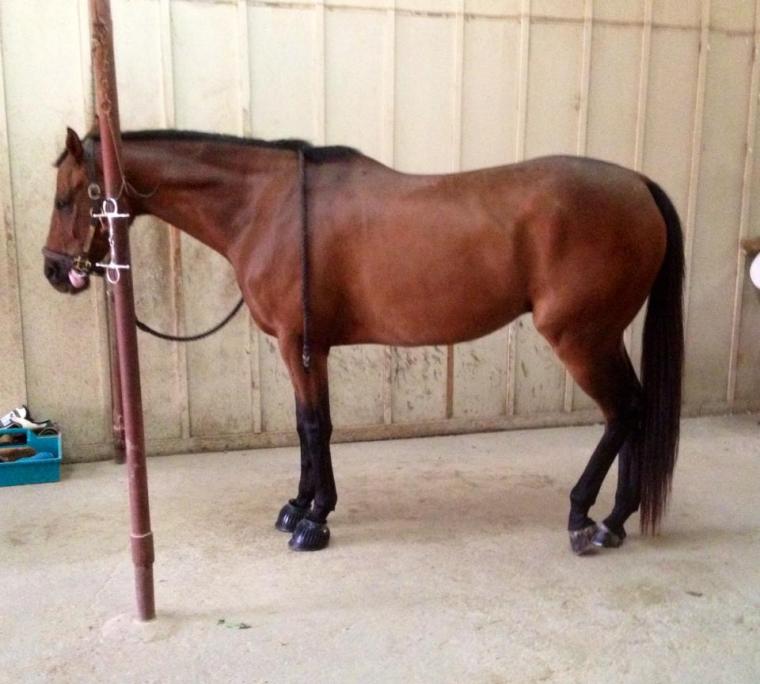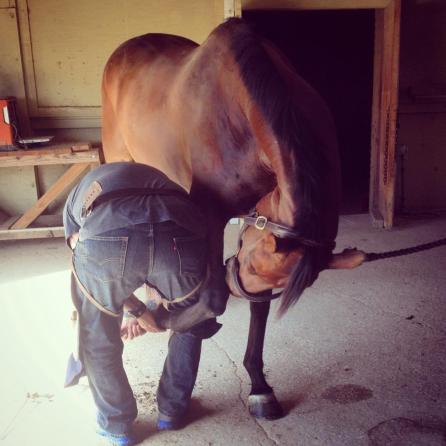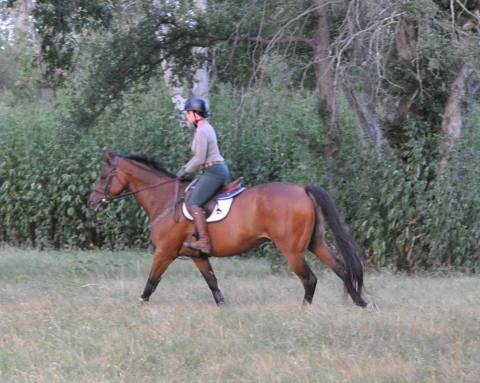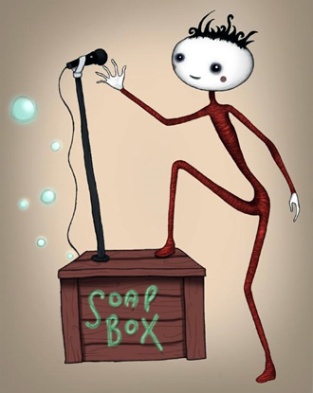Warning: this is a kinda lengthy diatribe comprised of a lot of personal opinion.
Like everyone else, I’m a big fan of keeping horses sound and happy for as long as possible. My first horse was purchased as an older, been-there-done-that jumper. Being a teenager I really didn’t know a whole lot yet about how to keep a horse sound long term, so it took until he was starting to come up pretty sore in the hind end before the vet was called. He flexed quite lame in both hocks… it was past the point of prevention and now to the point of treatment. Hock injections were the only option. The first injections lasted him a year, the next lasted 6 months, then after that they were wearing off in just a few months. That was when I decided to retire him.
I learned a lot from that horse about how I want to manage my future horses, especially the young ones, to help ensure future soundness. I will admit that sticking a needle in a joint scares the absolute crap out of me and I think our sport in general is way too blasé about it, thus I’m a big believer in doing everything possible before it gets to that point. Over the years with lots of horses and lots of different experiences I’ve narrowed it down to my 4 big things:
Feet, footing, turnout, joint support.
Feet have to be well balanced and maintained meticulously. If that means a 4-5 week shoeing cycle, so be it. If that means some kind of special shoeing to help support a conformational or gait abnormality, lets do it. I just can’t/won’t deal with bad farrier work.
Footing… I really believe that bad footing is the worst thing for a horse’s long term soundness. It’s so imperative that it be even, the right depth, well maintained, and of proper material. Years of working in bad footing or even just sub-par footing can have really detrimental effects on a horse’s long term soundness, whether it be too much concussion on the front feet, too much strain on the hocks, repeated micro-tears in soft tissue, etc. I won’t board at a barn with bad footing and I won’t go to a horse show with bad footing. That’s made me the subject of ridicule at times and I know I’m a nut about it, but footing. All horse people should try to educate themselves on what makes the difference between good footing and bad footing, and reading this article is a good start. It’s amazing how many people just don’t know the difference. And IMO the good footing rule extends to turnout as well. I’d rather mine stay inside for a day than be turned out in slick mud. Overprotective mom? Maybe.
As far as joint support, I’ve never been a big fan of oral supplements. I really think that they pee/poop most of it out, and that stuff is not cheap. With the past couple show horses I’ve had I developed a great love for Pentosan, which is an IM injection. Watch this video. The basic gist is that it can help both prevent and repair damage in the joint. The best thing is that if you can get a prescription for it you can order it from Wedgewood for only about $14 a dose. Much cheaper than oral supplements, you know the horse is actually getting it, and IM injections are easy. Pretty much all of my horses over the age of 6-7 that are in work go on Pentosan.
The reason I’m rambling about all this is because it’s been on my mind a lot lately as I’ve made a few choices for Henry. He’s been great, soundness wise, knock on wood, but I want to keep him that way. So I got vet and farrier to team up to figure out some shoeing changes that will help support him a bit better (bar shoes for the crooked legged, very naturally low-heeled creature) and his Pentosan injections start today. Let’s face it, even though he’s only 7 and he didn’t race, he spent a lot of time in race training and now he’s a jumper… neither of those are easy lifestyles. If doing a few little things now to go the extra mile will give him better quality of life well into and past his prime, it’s totally worth it to me. I’d rather prevent problems now than treat problems later.
This is not to hate on people who do IA injections on their horses… not at all. I absolutely believe in doing what needs to be done to help the horse, and if Henry really needed it I’d do it in a heartbeat (and probably then make some changes to his lifestyle/program as a result). This is geared toward no one in particular but really just horse sports in general. I obviously had way too much time to stand there and think while the farrier was doing his thing last night. 😉 My stance is merely one of trying to get people to pause and assess their program, asking themselves “what else?” or “what can I do now?”, thinking of it in terms of preventing problems instead of reacting to them after the damage is already done. I wish someone had asked me that 15 years ago.
Soapbox dismount.







thanks for sharing your insights on this. most people will have varying mileage on all these topics, but general education (like the linked articles) is always helpful! i’m struggling a bit with my leased mare – having never owned a horse, i don’t have that foundation of knowledge on keeping them sound. she’s 13 and working harder than ever before… and i’m concerned. if she were mine, she’d be on pentosan in a heart beat. but she’s not mine, my hints are not heard by the owner, and i don’t want to get shrill about it…
LikeLike
I work at a dressage barn and the horses start getting joint injections quite early. And before they need them. Which I do disagree with.
I’ve been lucky with Apollo, he isn’t on anything and he’s 15. But he was started late (at 8 years old) and hasn’t done much jumping/hard work haha. I I have tried a few oral supplements but I haven’t really seen any changes.
I’m curious how he will hold up as we try our hand at some low level eventing next season, I will certainly keep your post in mind 🙂
LikeLike
I am a big fan of all of the points you made in this post. We should be taking all the preventative measures we can for our horses long term soundness and comfort.
I really need to get my injectable supplement optkon figured out! Want to stretch my injection as long as I can.
LikeLike
Great post. Preventive maintenance is MUCH better and much less expensive in the long run, and I wish more people were convinced of that. But also the exercise, conditioning, and training can go a long way to keeping a horse sound over time. If a horse isn’t muscled, conditioned, and supple enough to support his joints, tendons, and ligaments, and the impact joints and hooves take, the rest of it can only go so far. You wouldn’t hang out at your house for a week doing nothing, and then go run a marathon. At least, I hope not.
LikeLiked by 1 person
Another good point! Conditioning is super important.
LikeLike
LOVE everything you said in this post! I totally agree with it all…as humans, we try to eat healthy-ish and exercise kinda-sorta regularly to help prevent long-term problems like obesity and osteoporosis and whatnot in the future, why not do the same for our horses? Its’ only money, right (which seems to be the theme of the past 2 days)? 😉
And Henry has entirely too many adorable faces, I don’t know how you even attempt to ride instead of just watching his face 24/7 haha.
LikeLike
“It’s only money, right?” – what will be engraved on my tombstone, I’m sure. The best thing about preventative maintenance is that it can be so cheap and easy, if you’re smart about it. Way cheaper than treatment/more invasive maintenance later on.
LikeLike
Agree!
PS…I’ll down in Austin in November, we’re having margaritas 🙂
LikeLike
Woot! I’m down. I’m assuming that by saying margaritas, queso is also implied.
LikeLike
You are correct, because in Austin, you absolutely cannot have margaritas without queso…I’m pretty sure it’s against the law 🙂
LikeLike
yes, really great post. and it’s timely. i’m starting to feel a bit worried about auto’s right hind, but i’m feeling a bit lost as to the way forward. it’s imperceptible to anyone but me, but i’m pretty sure something’s NQR. i know next to nothing about injections and such, but definitely going to dig into learning more about pentosan. thanks for getting on your soap box so we can all learn a bit more.
LikeLike
Trust your gut! It always knows best. 😉
LikeLike
UGH footing! Why does no one else care about footing?! Literally so glad to read this because most people look at me like I have 8 heads when I refuse to ride my horse in arenas/venues with shitty footing. It is so important, and I cringe whenever I go to barns/shows/clinics/etc. and see horses shuffling around in crappy footing.
/end rant
LikeLike
I’ve gotten that same look too, and a lot of whispering behind my back, but at the end of the day we have to make decisions that we are comfortable with. If something happened to my horse because I ignored a gut feeling, that’d totally be on me. I’d rather be safe than sorry. So I’m totally with you on that one!
LikeLike
I agree with Karen above that conditioning is another important factor. I also think that regular movement is key. Being on 24/7 turnout has kept my arthritic horse sound when nothing else could.
LikeLike
Yes yes yes^^ I forgot to mention turn-out in my comment!
LikeLike
Totally with you on the preventative maintenance and with Karen on conditioning. Playing a 7 minute game of polo at a gallop is no small physical feat and the proper conditioning will keep the ponies sound through the season. I wish that more polo players would invest in Adequan or Pentosan for their horses and pay attention to things like saddle fit.
Preach it, sista!!! 😉
LikeLike
Saddle fit (or just a general “fit and quality of equipment”) is a biggie, too!
LikeLike
What is the link to Wedgewood? I’ve never heard of it, & had no luck searching. My friend’s mare is on Pentosan, & I know she’d be ecstatic to get it for cheaper! 🙂
LikeLike
http://www.wedgewoodpetrx.com/ You need a Rx from the vet to get it compounded. I buy the 50mL bottle, which is $109.
LikeLiked by 1 person
Awesome, thanks! 😀
LikeLike
From working at SP for a few years I should probably claim that all feed throughs are amazing and will cure anything, however most people who research (even SP people) will tell you that joint supps work best as a preventative, not a cure. I also prefer injectibles like adequan/pentocan/legend to feed throughs, and wish my horse didn’t have such advanced arthritis for a horse his age. If he were more normal, we’d be doing a regular injectible instead of straight up hock injections.
LikeLike
Love this. All of this. Farriers are gifts from above, and to me are the reason horses are able to maintain a comfortable career. As for the preventables, I’ve been looking into Pentosan, as O gets into more work I’d love to be able to slow down and prevent any possible injuries down the line.
LikeLike
Good call on the injectible stuff… I’ve never had any luck with the feed-throughs but definitely noticed a difference using injectible glucosamine. Footing, conditioning, the proper trim/shoes for the horse’s conformation and movement… all super important too! Great post.
LikeLike
Great post – and good point about footing, which is important but doesn’t often come to mind in terms of good preventative maintenance practices. However, I think we consumers need to be careful about companies trying to take advantage of our desire to help support and/or maintain our horses’ joints/muscles/digestive/everything. Especially since lots of products are NOT research-proven.
LikeLike
True, which is why people should use their own judgement (along with the guidance of their vet) to make decisions on what works best for them and their horse. I do think the amount of supplementation can be crazy sometimes, when really everything could be addressed with good diet, proper exercise, and a little preventative maintenance (in whatever form – footing/farrier/joint support/etc).
LikeLike
Preach it! I am soooooo with you on preventative!!
LikeLike
All good points – excellent post.
Re supps – I have a source for human grade hyaluronic acid which I give orally in a gel that I mix daily. VERY affordable. $5 per month. Bonus is you can put the residue on yourself – all the best face products use it. Can’t prove it’s effective, but at that price I’ll take the risk.
I found Pentosan online a few years back, when Adequan became unavailable for 6 months or so. Researched the bejesus out of it, sent all info to my vet, and got the scrip so I could order. (from Wedgewood)
My findings were, that there are research proven results for Pentosan. Not a scientist so I can’t confirm the relevance of studies – but the only study for Adequan was paid for by – wait for it – Luitpold. (the manufacturer of Adequan)
Anecdotal evidence: Val is way more comfortable. I barely see him cock his left hind when resting anymore – he stands squarely most of the time now and moves out beautifully. Half the price and way more effective.
LikeLiked by 1 person
Really loving this post. I got my Quarter two years ago and immediately put him on supplements. I’m using a joint supplement that goes in his feed. First thing I bought and it’s done wonders, he loves it and so far so good, but I’ve been looking into the injections for the future if I ever need to switch things up. Granted, he’s 13 now and should’ve been put on something sooner, considering he’s got a straighter shoulder so prone to arthritis in his front legs (which he has, very mildly and barely noticeable, however it’s there) and he’s stinking *huge* and built like a tank.
Amen and amen on the good footing and good farrier. I refuse to ride on bad ground, absolutely refuse. It’s caused me a lot of stress with soundness and I’m done with bad footing.The first thing I looked at on our new farm was the ground. Now, I insist that all of my future horses get on preventative and my mom has jumped on the bandwagon, too.Excellent post!
LikeLike
Good post. And I agree, I have had some success with feedthroughs as preventative but it doesn’t nearly touch what injectables can do. Frankly I wish I could go about injecting myself. Equestrianism is hard on the body (and greater fitness in both horse and rider = less lameness for both I’ve also found).
LikeLike
Seriously. I’m getting Pentosan for my dog as well and was like… hmmm can I just dose myself while I’m at it?
LikeLike
Great post! And something that I will be looking into for the new girl! Thanks for the tip on the Pentosan- going to look into it!
LikeLike
Both my boys are on Ichon monthly (basically adequan but FDA approved for joint lavage instead). They were on adequan until it became unavailable. I’ve considered trying pentosan instead but both horses are doing fine and it’s $24/dose so not bad in price either.
When stampede got diagnosed with kissing spines injecting was the only option I was offered so we did that. Not the best results and I’m thankful that more options seem to be popping up all the time. He’s been getting shockwave treatments so I’ve been reading about that. Very interesting stuff!
P got injections in his hocks while I didn’t own him so I did do it once. I had never seen it done and it was pretty creepy! I didn’t see big results and he is sound for what we do with the monthly so we just truck along now. I’m not against them but I would try other things first knowing what I know now. I think injections seem easy so they became the go to option.
PS I hate hard and/or uneven footing. Our one riding ring at the barn was a brick all last summer (and part of this summer) and it was so maddening.
LikeLike
Good common horse sense! Footing is always looked over – should be right at the top!
LikeLike
Great post! Thanks for sharing. Probably the #1 factor for me in keeping a horse sound is conformation. We try to breed horses with straight legs for a reason. That’s more a horse breeder consideration than a rider consideration, though.
LikeLike